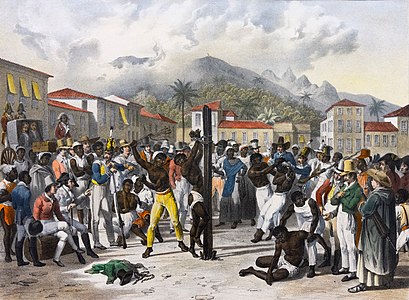Commons:Featured picture candidates/File:Johann Moritz Rugendas in Brazil.jpg
Jump to navigation
Jump to search
File:Johann Moritz Rugendas in Brazil.jpg, not featured[edit]
Voting period is over. Please don't add any new votes.Voting period ends on 13 Dec 2019 at 01:56:25 (UTC)
Visit the nomination page to add or modify image notes.
- Category: Commons:Featured pictures/Non-photographic media/People#Groups
 Info Author: Johann Moritz Rugendas. Uploaded and nomination by-- Wilfredor (talk) 01:56, 4 December 2019 (UTC)
Info Author: Johann Moritz Rugendas. Uploaded and nomination by-- Wilfredor (talk) 01:56, 4 December 2019 (UTC) Comment - Certainly an important image, but why is the near right corner, and especially the man nearest to it, unsharp and lacking in the grain of the rest of the lithograph? (And by the way, a lithograph is a print, not a painting, so unless this is a lithograph copy of a painting, the English-language description should be changed, and if it is, it should be changed to reflect that, too.) -- Ikan Kekek (talk) 06:34, 4 December 2019 (UTC)
Comment - Certainly an important image, but why is the near right corner, and especially the man nearest to it, unsharp and lacking in the grain of the rest of the lithograph? (And by the way, a lithograph is a print, not a painting, so unless this is a lithograph copy of a painting, the English-language description should be changed, and if it is, it should be changed to reflect that, too.) -- Ikan Kekek (talk) 06:34, 4 December 2019 (UTC)
- It was the original name in the museum, and unsharp area is lack of DoF --Wilfredor (talk) 23:02, 4 December 2019 (UTC)
- What was the original name? Are you saying the museum called a lithograph a painting? I don't get it. -- Ikan Kekek (talk) 01:01, 5 December 2019 (UTC)
- There are ways to paint on a lithograph and I think this was what the museum was trying to explain when placing this description. First of all we must understand that the term we use today as "lithography" is a connotation of the literal term that refers to engraving an original work in another material through the use of plates or molds developing a reciprocal diversion between lipophilic and hydrophilic substances. Method invented by the German, Aloys Senefelder. But like everything in this bizarre world we change or distort the intention. Today a lithograph is the replica of an original work printed on its variable presentations. Like the different items or products we use every day, to name a few, shoes, transport or houses. Pictorial art has suffered the benefits and cons of serial production. A work, commonly called "box" is the result of artistic work in its different techniques; oil, acrylic, watercolor, gouache, wax, pastel, ink, charcoal, etc ... until you get to mixed media, mixing of various components or techniques. To be able to differentiate a work from a "lithography", or graphic printing, lies in meticulously observing the pigments and looking for whether the piece contains print marks, squares that we can detect synonymous with a digitally produced work. Another feature of graphic prints is that it has a commonly white frame and bears the name of the artist digitally printed. Another feature of lithographs is the use of glass or mica on prints. On the other hand an original work, you will usually find it in a gallery or a museum. Same that are collected in restaurants, hotels, offices and residences. We can observe in detail the brushstrokes of the author, seeing a slight texture or wavy, traces of which there was a stroke of a brush, or spatula. A characteristic point that stands out is the signature of the artist, as this is almost always done after the sealant is applied to the work, therefore the signature stands out. It is also worth mentioning that today there are very efficient printing methods that result in a lithography with texture similar to that of an original work, but you can still recognize digital printing features. I hope this explanation helps to understand why it is like this in the description --Wilfredor (talk) 14:01, 5 December 2019 (UTC)
- Thanks. I appreciate the discourse on art history and methods, but what I really wanted to know is that it's a replica of a painting. That's the key point to me. -- Ikan Kekek (talk) 18:34, 5 December 2019 (UTC)
- Sorry, this is a replica that then someone painted on it --Wilfredor (talk) 19:19, 5 December 2019 (UTC)
- I see. Thanks for clarifying that. -- Ikan Kekek (talk) 19:52, 5 December 2019 (UTC)
- Thanks you for the question, good morning --Wilfredor (talk) 21:03, 5 December 2019 (UTC)
- And good evening now. I would really love to support this nomination, but the unsharp spot makes me feel it's not an FP. Regardless of what happens here, I would like to see this as a VI. -- Ikan Kekek (talk) 04:36, 6 December 2019 (UTC)
- It is particularly difficult to take photos in museums, I think I did not use enough depth of field --Wilfredor (talk) 15:18, 6 December 2019 (UTC)
- It was the original name in the museum, and unsharp area is lack of DoF --Wilfredor (talk) 23:02, 4 December 2019 (UTC)
 Oppose per discussion above. Daniel Case (talk) 16:52, 6 December 2019 (UTC)
Oppose per discussion above. Daniel Case (talk) 16:52, 6 December 2019 (UTC) Oppose not an excellent picture for me --Fischer.H (talk) 17:58, 8 December 2019 (UTC)
Oppose not an excellent picture for me --Fischer.H (talk) 17:58, 8 December 2019 (UTC)
Confirmed results:
